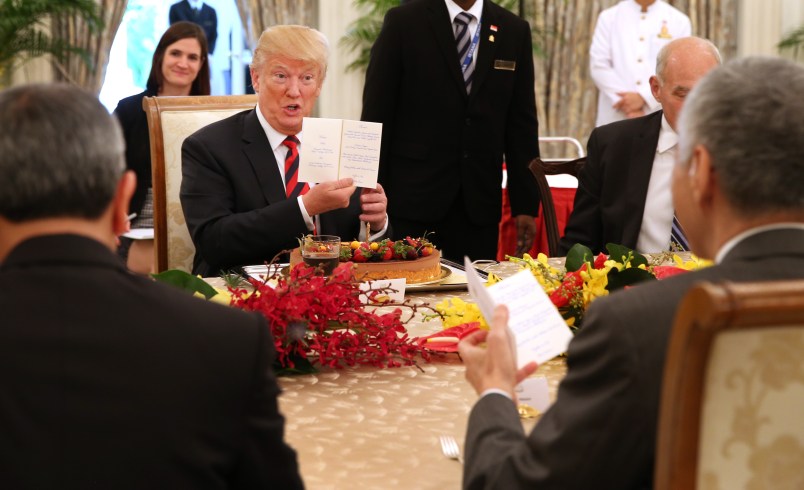As I’ve explained my thinking on the US-North Korea summit in a series of posts. Let me share a few more thoughts as we get underway.
For starters, the current mode is vastly preferable to where we were 6 months ago. This basic fact cannot be lost in all the critical discussions of President Trump’s bad acts and dubious actions in East Asia. We should also note that going into the summit the US appears to be moonwalking back any discussion of North Korea abandoning its nuclear weapons arsenal or strategic delivery systems (the ICBMs). On the contrary, the White House is going into the engagement talking about a second summit at Mar-A-Lago, an exchange of Ambassadors, a guarantee of the security of the North Korean government/regime and lots of money.
All of these points seem guaranteed to signal that Kim Jong-Un has the upper hand in the encounter. We’re backing off anything he needs to do and falling over ourselves to offer more things. This seems driven by a mix of naivete, a penchant for making friends with foreign autocrats and as much as anything Trump’s desire for a “win” going into the 2018 midterms. None of those suggest anything good as an outcome. This is all the more so since President Trump seems set on dismantling the core strategic theory underlying US alliances in Europe and East Asia. The best we can hope for is for nothing major to go wrong and to keep on the talking rather than threatening posture we’ve been in since the Spring.
But there’s one slightly discordant note to this or at least a possible opportunity out there. It’s raised in this article by Jane Parlez in The New York Times. Things are moving so rapidly and so indifferent to traditional policy channels that China is starting to get a bit jittery itself about the outcome of the Kim-Trump summit. Put most baldly, what if Kim decides to switch sides? From a fraternal and deeply entwined relationship with the PRC, its only major power ally, to the United States?
This seems ridiculous when you hear it. And even the Times article grants that something quite that dramatic is highly unlikely. But there’s a slimmed down, modified version of this idea that is not altogether implausible. China borders North Korea has been its economic and trade lifeline and is its only real ally. In all human relations, we know that profound dependence can create resentment. The article suggests that Kim would like to carve out more room for maneuver, more independence from all parties. In other words, he might want to build some relationship to the United States in order to play the US and China off against each other for advantage in both directions. (Independence is the centerpiece in many ways of North Korean state ideology.)
The article also notes that it seemed equally unexpected and unpredictable when the US and China began their rapprochement in the early 1970s. (People often forget that Nixon’s opening to China came before any of China’s economic liberalization. Indeed, it was in the quieter latter period of the Cultural Revolution, a highly chaotic and repressive era.) This isn’t a perfect analogy though. The opening between China and the United States was based on common hostility to the Soviet Union. Relations between the PRC and the Soviet Union had been in a downward spiral since the early 1960s. Indeed, the two countries actually had sporadic military confrontations on their border in the late 1960s. So China’s interest in finding counterweights to the Soviet Union was not a surprise. What was a surprise is that China and the US could overcome their ideological hostility and deep history of confrontation to act on what was an obvious and logical move in geopolitical terms.
Despite some common players, the two cases are quite different. And yet, the way that the rapprochement dramatically shifted the geopolitical situation to each side’s advantage is an interesting parallel. Having warmer relations with the US and South Korea could open up a bigger range of possibilities for the North.
The problem with this theory is that basically every North Korea expert I know tells me that the perpetuation of the Kim family’s regime is based not only on fierce repression but on the reality and propaganda about a diabolical outside threat, namely the United States and its purported pawn South Korea. That probably puts great limits on any sort of rapprochement which might make sense in geopolitical terms. The best way to look at this is that it’s a concern on the margins for China, an opportunity on the margins for us. Any sense that a real shift is possible seems fanciful. But some repositioning, seem strategic ambiguity seems both possible and advantageous.
In any case, I think our bigger threat is that Trump will give away everything in an effort to secure a win and demoralize our regional allies who count on stability and no wild gyrations in US security policy in the region. But these are still intriguing possibilities. Whether Donald Trump has any ability or interest to play on them in advantageous ways is another matter entirely.






